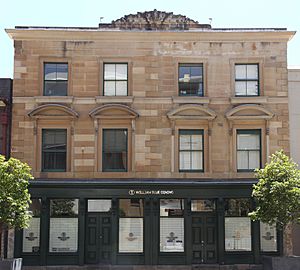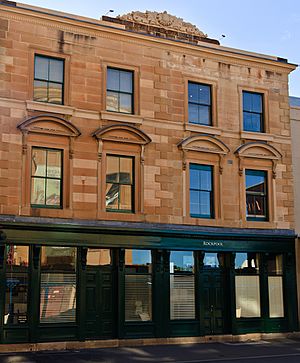107-109 George Street, The Rocks facts for kids
Quick facts for kids 107–109 George Street, The Rocks |
|
|---|---|

The façade of the building, pictured in 2019.
|
|
| Location | 107–109 George Street, The Rocks, City of Sydney, New South Wales, Australia |
| Built | 1860–1860 |
| Architectural style(s) | Victorian Regency |
| Owner | Property NSW |
| Official name: Rockpool Restaurant (former); William Blue Dining | |
| Type | State heritage (built) |
| Designated | 10 May 2002 |
| Reference no. | 1590 |
| Type | Shop |
| Category | Retail and Wholesale |
| Lua error in Module:Location_map at line 420: attempt to index field 'wikibase' (a nil value). | |
107–109 George Street, The Rocks is a special building in The Rocks, a historic area in Sydney, Australia. It used to be a shop, a home, and a bakery. Today, it is a restaurant.
This building was built in 1860. It is also known as the former Rockpool Restaurant and William Blue Dining. The government of New South Wales owns it. Because of its history and design, it was added to the New South Wales State Heritage Register on May 10, 2002.
Contents
A Look Back: The History of 107–109 George Street
This spot has a long and interesting past. It was part of the very first hospital grounds in Australia, way back in 1788. By 1790, a new hospital was built here.
Around 1800, there were three hospital buildings. This specific site was likely between them. By 1812, some small buildings, possibly hospital storage, stood here.
In 1816, a new hospital opened on Macquarie Street. The old hospital on George Street was torn down. This area then became a government stone quarry.
Early Buildings and Owners
Later, the land was given to a person named Mr. Broughton. His wife, Elizabeth, seems to have owned it. The Broughtons built a house and a shop here around 1832 or 1833.
In 1841, the land was split into four parts and sold. Lot 1 is now 109 George Street, and Lot 2 is 107 George Street. Maps from that time show a shoe shop on Lot 1. There was also a house and shop belonging to Mr. Bradley. This shop was small, with wooden walls and a shingled roof.
John Donohoe bought Lot 2 (number 107) in 1842. He quickly built a wooden bakehouse with a shingled roof. It seems Donohoe bought both lots, as he was listed as the owner in 1845.
Freehill's Development and Changes
In 1854, Patrick Freehill bought Lot 2. He then bought Lot 1 in 1856. Freehill built a bakehouse and a store behind his properties in 1857. This stone store was three stories tall and had ovens and stables. You can still see parts of its lower walls today.
In 1860, Freehill built the four-story buildings we see now on both lots. The southern part of this building became a public house (a type of hotel) in 1863. It had stone walls and a slate roof.
Freehill kept the bakehouse and store at the back of Lot 1. But he sold the public house, called "The Shipwrights Arms," in 1868. The property later went to the Bank of New South Wales. It stayed a hotel until 1900, when its name changed to the "Chicago Hotel."
Government Ownership and Modern Uses
The government took over 107 and 109 George Street in 1901. These buildings were strong and relatively new, so they were not torn down like others nearby.
Around 1910, the hotel at 109 George Street became a fish shop, then a café. Number 107 George Street was a clothes shop until the early 1920s, then a hairdresser.
By the 1960s, 107 George Street had a laundry and a museum. Apartments were on the upper floors. Number 109 was a restaurant called The Rocks Push.
The building was changed a lot in the late 1900s. In 1978, The Rocks Push Restaurant expanded into 107 George Street. This meant big changes, including removing the wall between the two properties. The top part of the sandstone façade (the front of the building) was also rebuilt.
In 1980, the shopfront of 107 George Street was rebuilt to look like the original one at 109. After 1985, the old residential doors were removed. The paint was also taken off the sandstone front.
The ground floor was changed again for the famous Rockpool restaurant. Chef Neil Perry opened Rockpool in February 1989. In 2009, the building had more work done to keep it in good condition. A carved stone decoration, called a pediment, was put back on the roof.
As of 2019, the building is home to William Blue Dining. This is a restaurant run by students from the William Blue College of Hospitality Management. It helps them learn how to serve food and drinks in a real restaurant setting.
What It Looks Like: Building Description
Construction on 107–109 George Street began in 1861. These buildings have three main floors, plus a basement and an attic. The front of the building, facing George Street, is made of sandstone. The back is made of brick.
The sides of the buildings are covered in smooth, rendered brick. A brick wall separates the two buildings inside. Each property has a hipped roof (a roof that slopes down on all sides). There are also two brick chimney stacks on the roof, each with six chimney pots.
At the back of both buildings, there's a single-story section. This part includes some older sandstone walls from 1857. The roof here was built in 1988 for the Rockpool restaurant.
In 1988, a company called D4 Design updated the ground and first floors. This was for Neil Perry's Rockpool restaurant.
The building's style is Renaissance Revival. It has three stories plus a basement. The roof is covered in iron, and the floors are made of timber.
Building Condition and Changes
As of 2001, the area underground was partly disturbed. This means there might be old things buried there.
Here are some important changes made to the building:
- 1861/1857: The original construction.
- 1988: Major updates for the Rockpool restaurant.
- 2009: Work to preserve the building, including putting a replica pediment (a triangular decoration) back on the roof.
Why It's Special: Heritage Listing
The Rockpool Restaurant building and its site are very important to the history and culture of New South Wales. They are also part of The Rocks area, which is special on its own.
The buildings at 107–109 George Street are a key part of The Rocks. They show how the area has changed since the first colony was set up. They also highlight the importance of the Circular Quay area for business in the mid-1800s.
This building is a great example of commercial buildings from the mid-Victorian Regency period. Its design shows how confident people were about this area when it was built by Patrick Freehill.
These buildings are also special because they were once a shop and a home combined. You can still see signs of this old use, which is rare now.
Historical Importance
The buildings at 107–109 George Street are historically significant for several reasons:
- The site was part of the first hospital in the colony.
- It shows how private businesses grew in The Rocks in the mid-1800s.
- The building's fine sandstone design is a good example of this time.
- Its history reflects the general changes in The Rocks.
- The refurbishment around 1970 was one of the first done by the Sydney Cove Redevelopment Authority. This was an important time for The Rocks.
- Having shops on the ground floor and homes above was common back then.
- The buildings have been used for business continuously since 1861. They were a hotel and bakery, then a barber and restaurant.
Connections to Important People and Groups
These buildings are important because:
- They are in The Rocks, an area linked to Australia's early convict settlement.
- The site was home to Australia's first hospital.
- It's on George Street, one of Australia's oldest business areas.
- The site was one of the first buildings restored by the Sydney Cove Redevelopment Authority.
- It's connected to famous Sydney restaurants, like The Rocks Push and Rockpool with Chef Neil Perry.
Beautiful Design and Architecture
The buildings at 107–109 George Street are beautiful because:
- They show high-quality Victorian Regency design. Look for its balanced front, decorative stone top, and classic details.
- They fit well with other commercial buildings on George Street. They have similar size and details.
- The front of the building has stayed mostly the same since 1861, except for the loss of the original verandah.
- The inside design of the Rockpool restaurant from 1988 is also important. It shows modern design ideas.
Community and Cultural Value
The buildings at 107–109 George Street are socially important because:
- The Rocks is a popular place for both locals and tourists.
- People care deeply about this area. When it was threatened, many spoke up to protect it.
- The Rockpool Restaurant became a famous Sydney dining spot with Neil Perry as its head chef.
Learning from the Past: Research Potential
These buildings can help us learn about history because:
- The building's structure can show us how early Victorian commercial and residential buildings were made. It can also tell us about the lives of the people who lived there.
- The site might have old things buried underground from the early settlement period.
- These buried items, along with old documents, can give us information about The Rocks that we can't find anywhere else.
Unique and Rare Features
The buildings at 107–109 George Street are rare because:
- The intact sandstone front on George Street is a very fine example of mid-Victorian Regency architecture. It's rare to see this style on commercial buildings built by individuals back then.
- They still have parts that show they were once both a shop and a home. This used to be common but is now rare in the business district.
A Great Example of Its Kind
The buildings at 107–109 George Street are a good example of:
- The old buildings found in The Rocks from the 1800s.
- Early Victorian commercial properties built in the Victorian Regency Style.
- Buildings that have been used for business continuously since 1861.
- The typical size, details, and street alignment of buildings on George Street in The Rocks.
- The rich history of The Rocks, which is highly valued by many.
- The potential for archaeological finds that can tell us about Sydney's history.
- One of the first projects by the SCRA (Sydney Cove Redevelopment Authority) when it was restored around 1970.


